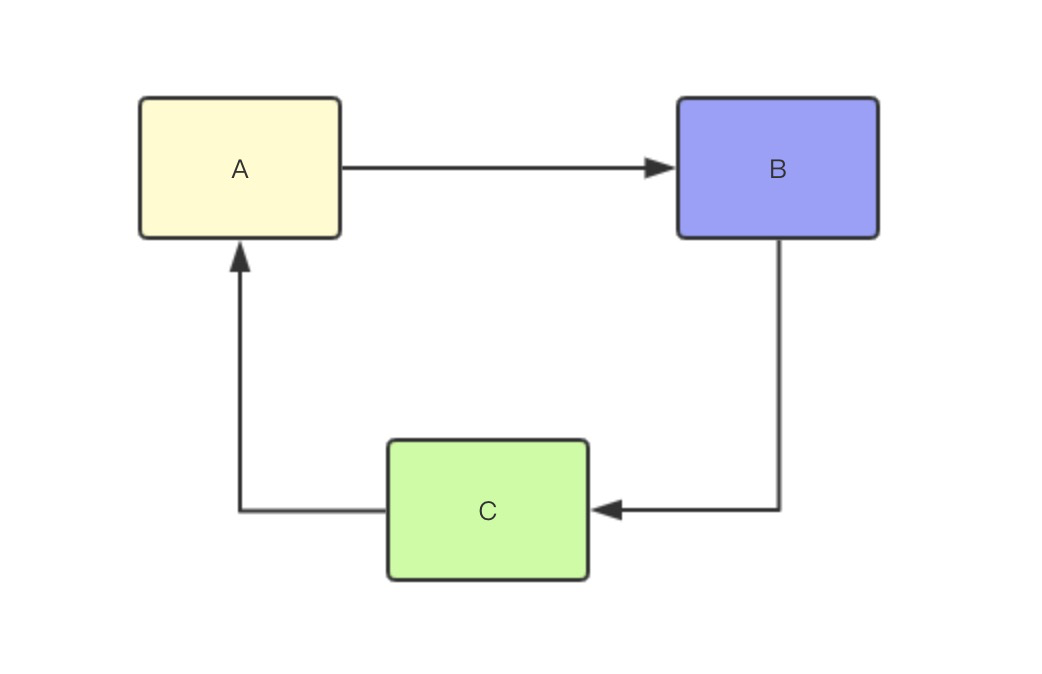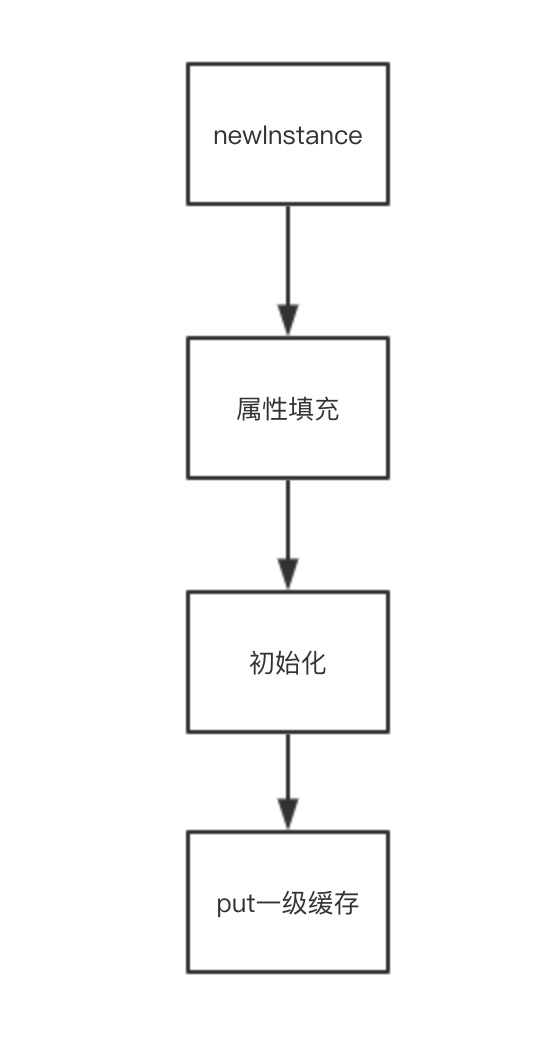您好,登錄后才能下訂單哦!
您好,登錄后才能下訂單哦!
今天就跟大家聊聊有關Spring中怎么解決循環依賴,可能很多人都不太了解,為了讓大家更加了解,小編給大家總結了以下內容,希望大家根據這篇文章可以有所收獲。
循環依賴,其實就是循環引用,就是兩個或者兩個以上的 bean 互相引用對方,最終形成一個閉環,如 A 依賴 B,B 依賴 C,C 依賴 A。如下圖所示:

Spring中的循環依賴,其實就是一個死循環的過程,在初始化 A 的時候發現依賴了 B,這時就會去初始化 B,然后又發現 B 依賴 C,跑去初始化 C,初始化 C 的時候發現依賴了 A,則又會去初始化 A,依次循環永不退出,除非有終結條件。
一般來說,Spring 循環依賴的情況有兩種:
構造器的循環依賴。 field 屬性的循環依賴。 對于構造器的循環依賴,Spring 是無法解決的,只能拋出 BeanCurrentlyInCreationException 異常表示循環依賴,所以下面我們分析的都是基于 field 屬性的循環依賴。
在前文 Spring Ioc源碼分析 之 Bean的加載(三):各個 scope 的 Bean 創建 中提到,Spring 只解決 scope 為 singleton 的循環依賴。對于scope 為 prototype 的 bean ,Spring 無法解決,直接拋出 BeanCurrentlyInCreationException 異常。
為什么 Spring 不處理 prototype bean 呢?其實如果理解 Spring 是如何解決 singleton bean 的循環依賴就明白了。這里先留個疑問,我們先來看下 Spring 是如何解決 singleton bean 的循環依賴的。
在AbstractBeanFactory 的 doGetBean()方法中,我們根據BeanName去獲取Singleton Bean的時候,會先從緩存獲取。
代碼如下:
//DefaultSingletonBeanRegistry.java
@Nullable
protected Object getSingleton(String beanName, boolean allowEarlyReference) {
// 從一級緩存緩存 singletonObjects 中加載 bean
Object singletonObject = this.singletonObjects.get(beanName);
// 緩存中的 bean 為空,且當前 bean 正在創建
if (singletonObject == null && isSingletonCurrentlyInCreation(beanName)) {
// 加鎖
synchronized (this.singletonObjects) {
// 從 二級緩存 earlySingletonObjects 中獲取
singletonObject = this.earlySingletonObjects.get(beanName);
// earlySingletonObjects 中沒有,且允許提前創建
if (singletonObject == null && allowEarlyReference) {
// 從 三級緩存 singletonFactories 中獲取對應的 ObjectFactory
ObjectFactory<?> singletonFactory = this.singletonFactories.get(beanName);
if (singletonFactory != null) {
//從單例工廠中獲取bean
singletonObject = singletonFactory.getObject();
// 添加到二級緩存
this.earlySingletonObjects.put(beanName, singletonObject);
// 從三級緩存中刪除
this.singletonFactories.remove(beanName);
}
}
}
}
return singletonObject;
}這段代碼涉及的3個關鍵的變量,分別是3個級別的緩存,定義如下:
/** Cache of singleton objects: bean name --> bean instance */ //單例bean的緩存 一級緩存 private final Map<String, Object> singletonObjects = new ConcurrentHashMap<>(256); /** Cache of singleton factories: bean name --> ObjectFactory */ //單例對象工廠緩存 三級緩存 private final Map<String, ObjectFactory<?>> singletonFactories = new HashMap<>(16); /** Cache of early singleton objects: bean name --> bean instance */ //預加載單例bean緩存 二級緩存 //存放的 bean 不一定是完整的 private final Map<String, Object> earlySingletonObjects = new HashMap<>(16);
getSingleton()的邏輯比較清晰:
首先,嘗試從一級緩存singletonObjects中獲取單例Bean。
如果獲取不到,則從二級緩存earlySingletonObjects中獲取單例Bean。
如果仍然獲取不到,則從三級緩存singletonFactories中獲取單例BeanFactory。
最后,如果從三級緩存中拿到了BeanFactory,則通過getObject()把Bean存入二級緩存中,并把該Bean的三級緩存刪掉。
看到這里可能會有些疑問,這3個緩存怎么就解決了singleton循環依賴了呢?
先別著急,我們現在分析了獲取緩存的代碼,再來看下存儲緩存的代碼。 在 AbstractAutowireCapableBeanFactory 的 doCreateBean() 方法中,有這么一段代碼:
// AbstractAutowireCapableBeanFactory.java
boolean earlySingletonExposure = (mbd.isSingleton() // 單例模式
&& this.allowCircularReferences // 允許循環依賴
&& isSingletonCurrentlyInCreation(beanName)); // 當前單例 bean 是否正在被創建
if (earlySingletonExposure) {
if (logger.isTraceEnabled()) {
logger.trace("Eagerly caching bean '" + beanName +
"' to allow for resolving potential circular references");
}
// 為了后期避免循環依賴,提前將創建的 bean 實例加入到三級緩存 singletonFactories 中
addSingletonFactory(beanName, () -> getEarlyBeanReference(beanName, mbd, bean));
}這段代碼就是put三級緩存singletonFactories的地方,其核心邏輯是,當滿足以下3個條件時,把bean加入三級緩存中:
單例
允許循環依賴
當前單例Bean正在創建
addSingletonFactory(String beanName, ObjectFactory<?> singletonFactory) 方法,代碼如下:
// DefaultSingletonBeanRegistry.java
protected void addSingletonFactory(String beanName, ObjectFactory<?> singletonFactory) {
Assert.notNull(singletonFactory, "Singleton factory must not be null");
synchronized (this.singletonObjects) {
if (!this.singletonObjects.containsKey(beanName)) {
this.singletonFactories.put(beanName, singletonFactory);
this.earlySingletonObjects.remove(beanName);
this.registeredSingletons.add(beanName);
}
}
}從這段代碼我們可以看出,singletonFactories 這個三級緩存才是解決 Spring Bean 循環依賴的關鍵。同時這段代碼發生在 createBeanInstance(...) 方法之后,也就是說這個 bean 其實已經被創建出來了,但是它還沒有完善(沒有進行屬性填充和初始化),但是對于其他依賴它的對象而言已經足夠了(已經有內存地址了,可以根據對象引用定位到堆中對象),能夠被認出來了。
到這里我們發現三級緩存 singletonFactories 和 二級緩存 earlySingletonObjects 中的值都有出處了,那一級緩存在哪里設置的呢?在類 DefaultSingletonBeanRegistry 中,可以發現這個 addSingleton(String beanName, Object singletonObject) 方法,代碼如下:
// DefaultSingletonBeanRegistry.java
protected void addSingleton(String beanName, Object singletonObject) {
synchronized (this.singletonObjects) {
//添加至一級緩存,同時從二級、三級緩存中刪除。
this.singletonObjects.put(beanName, singletonObject);
this.singletonFactories.remove(beanName);
this.earlySingletonObjects.remove(beanName);
this.registeredSingletons.add(beanName);
}
}該方法是在 #doGetBean(...) 方法中,處理不同 scope 時,如果是 singleton調用的,如下圖所示:
 也就是說,一級緩存里面是完整的Bean。
也就是說,一級緩存里面是完整的Bean。
小結:
一級緩存里面是完整的Bean,是當一個Bean完全創建后才put
三級緩存是不完整的BeanFactory,是當一個Bean在new之后就put(沒有屬性填充、初始化)
二級緩存是對三級緩存的易用性處理,只不過是通過getObject()方法從三級緩存的BeanFactory中取出Bean
總結
現在我們再來回顧下Spring解決單例循環依賴的方案:
Spring 在創建 bean 的時候并不是等它完全完成,而是在創建過程中將創建中的 bean 的 ObjectFactory 提前曝光(即加入到 singletonFactories 三級緩存中)。
這樣,一旦下一個 bean 創建的時候需要依賴 bean ,則從三級緩存中獲取。
舉個栗子:
比如我們團隊里要報名參加活動,你不用上來就把你的生日、性別、家庭信息什么的全部填完,你只要先報個名字,統計下人數就行,之后再慢慢完善你的個人信息。
核心思想:提前暴露,先用著
最后來描述下就上面那個循環依賴 Spring 解決的過程:
首先 A 完成初始化第一步并將自己提前曝光出來(通過 三級緩存 將自己提前曝光),在初始化的時候,發現自己依賴對象 B,此時就會去嘗試 get(B),這個時候發現 B 還沒有被創建出來
然后 B 就走創建流程,在 B 初始化的時候,同樣發現自己依賴 C,C 也沒有被創建出來
這個時候 C 又開始初始化進程,但是在初始化的過程中發現自己依賴 A,于是嘗試 get(A),這個時候由于 A 已經添加至緩存中(三級緩存 singletonFactories ),通過 ObjectFactory 提前曝光,所以可以通過 ObjectFactory#getObject() 方法來拿到 A 對象,C 拿到 A 對象后順利完成初始化,然后將自己添加到一級緩存中
回到 B ,B 也可以拿到 C 對象,完成初始化,A 可以順利拿到 B 完成初始化。到這里整個鏈路就已經完成了初始化過程了
http://cmsblogs.com/?p=todo (小明哥)
看完上述內容,你們對Spring中怎么解決循環依賴有進一步的了解嗎?如果還想了解更多知識或者相關內容,請關注億速云行業資訊頻道,感謝大家的支持。
免責聲明:本站發布的內容(圖片、視頻和文字)以原創、轉載和分享為主,文章觀點不代表本網站立場,如果涉及侵權請聯系站長郵箱:is@yisu.com進行舉報,并提供相關證據,一經查實,將立刻刪除涉嫌侵權內容。